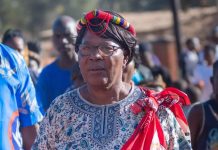Africa-Press – Malawi. Associate Professor of English Literature in the Department of Literary Studies at the University of Malawi, Ken Lipenga Jr, has stitched a book on rap music titled Rap Music and the Youth in Malawi: Reppin’ the Flames.
The development also follows Lipenga Jr’s exploits as a Fulbright Programme Visiting Scholar at Wesleyan University in United States of America, courtesy of US Embassy in 2021 when he gave a talk on how Malawian youth use rap music to express their political opinions.
The book identifies how Malawians have adapted hip-hop styles for their local context and illustrates how Malawian youth use hip- hop music to exercise agency and refutes stereotypes about ‘waithood’ among Malawian youth. Lipenga Jr said he was happy to have published the book.
“I was motivated to write the book by several factors, starting with my love for the genre. I have always appreciated rap music, from within Malawi as well as elsewhere. I have engaged in discussions about the state of rap music in the country with many friends and colleagues,” he said.
The Associate Professor said he realised that he could express some of his thoughts in a formal manner, through a book. “The other motivating factor was the realisation, as an academic, that many people outside Malawi do not know about this genre. I have read a lot about rap music from other countries such as Ghana, South Africa, Senegal and Tanzania,” Lipenga Jr said.
He added that there are actual books out there, in libraries and bookshops, showcasing this music from other countries, but nothing similar from Malawi.
“I realised that a book on the Malawian rap scene would help to put the music on the map, at least where academic discussion is concerned. I undertook some robust research in coming up with the book,” he said. Lipenga Jr said the bulk of the material in the book is to do with critical analysis of lyrics from some sampled songs on the Malawian hip-hop scene.
“I have carried out my analysis in a manner that draws attention to both the form and the content of the rap songs. However, my central aim is to illustrate how these songs serve various functions for the youth in Malawi, an important demographic both in terms of production and audience composition for the music,” he said.
In the book, the author argues that Malawian rap music is used to express a phenomenon called ‘waithood’, where the youth find themselves in a situation where they fail to attain economic independence, due to the absence of employment and other opportunities that would pave the way to responsible adulthood.
“Malawian rap music does not exist in a vacuum. Therefore, the research also involved making connections between the rap music practices in Malawi and those in other countries, both in Africa and outside,” Lipenga Jr said.
According to him, a key component of the research involved getting in touch with some of the rappers in the country, such as Suffix and Fredokiss, to obtain their insights on rap music in Malawi.
“Most rap artists were willing to share thoughts on their journeys in the industry. I am grateful for the permission and information granted by artists such as Phyzix, Ace Jizzy, Bee Jay, KYC Nyimbo, Waxy K, Krazie G, Seven O More, Gwamba, Macelba, and Hyphen to publish samples of their songs in the book,” he said.
Lipenga Jr further said that the analysis draws attention to features that illustrate their individual stylistic nuances, as well as those that could be deemed characteristic of Malawian rap music.
The book is divided into several chapters, focusing on different aspects of the Malawian rap music scene. For example, one of the earlier chapters interrogates the matter of language choice among rap artists, and how it relates to assertion of identity in the youth demographic.
Central to this chapter is the motivation for artists to rap in English, Chichewa, or any other languages, and indeed the choice to ‘code switch’ among different languages.
“This section also discusses why the ‘punchline’ is revered as a feature of rap verses. Other chapters examine the relevance of rap music to the country’s politics, the connection between rap music and alcohol consumption among the youth, the representation of the ghetto in the music, and the use of rap music in social activism, especially in relation to violence against people with albinism, and the dissemination of information about Covid-19,” he said.
Lipenga Jr said given the accusations levelled against rap music as a foreign music form, there is also a chapter devoted to illustrating how Malawian rappers have managed to make rap an accepted music genre within the country.
In terms of audience, the Associate Professor, said the language of the book is primarily aimed at an academic readership, but can also be accessed by anyone who is interested in Malawian music, especially the rap genre.
“Those who are interested in the production of rap music on the African continent, as well as its intersections with indigenous forms, will find the text to be of interest. Scholars of youth studies in Africa will also find the book to be a valuable resource,” he said.
Suffix of the ‘Mkazi Wakumwamba’ fame hailed Lipenga Jr for the move saying that this shows the importance of rap music. “He had talk on it and now with the book, this is huge. The impact that rap music has played in the country is huge. It has moved in phases and there was a time where many were using English but now we are using our local languages,” the Lilongwe-based rap, said.
The 198-page book has been published by Palgrave Macmillan, one of the top book publishers internationally and it is currently available on the publisher’s website and leading online bookstores such as Amazon and Barnes and Noble, in both hardcover and e-book format.
For More News And Analysis About Malawi Follow Africa-Press






